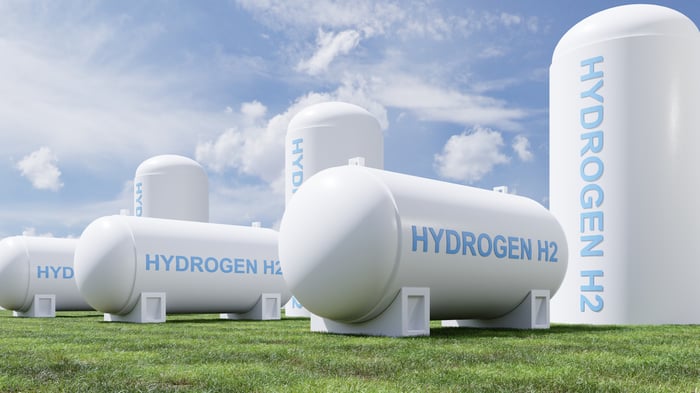As the world looks toward renewable fuel sources, Plug Power (PLUG -0.48%) aims to build on its hydrogen fuel cell technology and become a leader in the end-to-end hydrogen ecosystem.
These lofty ambitions could potentially pay off in a big way, thanks to the massive potential market for green hydrogen in the future. According to Deloitte consultants, the green hydrogen market is projected to skyrocket to an astonishing $1.4 trillion by 2050.
However, it's been a tough ride for Plug since its 1999 initial public offering (IPO). The company has struggled to find its footing, and its pursuit of building out hydrogen infrastructure has been an uphill battle. While the market opportunity is expansive, investors should consider the following before adding Plug Power stock to their portfolio.
Plug Power looks to become a significant player in green hydrogen
Plug Power provides hydrogen fuel cell solutions as an alternative to conventional batteries, helping produce clean and efficient energy with minimal carbon emissions.
The company develops products that harness the power of electrolysis to produce hydrogen from water, creating a green fuel source. Its liquefaction and cryogenic systems facilitate the efficient storage and transportation of hydrogen gas, making the fuel accessible and practical for various applications.
One of Plug Power's current products is GenDrive, a hydrogen-powered fuel cell system made for material-handling vehicles, such as forklifts. The company counts industry giants like Amazon and Walmart -- two of the largest e-commerce companies in the world -- among its clients.
In addition, Plug's vision is to create a comprehensive hydrogen ecosystem that includes producing, storing, transporting, and dispensing liquid green hydrogen. In 2023, Plug Power launched a 350,000-square-foot fuel cell manufacturing facility in New York designed to meet the growing demand for its fuel cells. Last year, the company began producing liquid hydrogen at its hydrogen production facility in Georgia, the largest green liquid hydrogen plant in the U.S.

Image source: Getty Images.
The hydrogen production facility is designed to produce 15 tons per day of liquid electrolytic hydrogen, or enough to power 15,000 forklifts daily. This facility boosts its supply of liquid hydrogen, which customers use in material handling, fuel cell electric vehicle fleets, and stationary power applications.
Plug Power's losses are piling up
One area where Plug has struggled is operating efficiently and generating positive cash flow. The company has consistently lost money; over the past twelve months, its net loss of $1.4 billion exceeds its revenue of $660 million.
To help fund its operations, Plug Power has had to issue a considerable amount of shares, which has significantly diluted shareholders' equity in the process. It has done so through stock offerings and subsidizing its fuel cell sales by issuing Amazon and Walmart stock warrants. The lack of profitable operations and ongoing dilution are key reasons why the stock has declined by 99% since its IPO.
PLUG Revenue (TTM) data by YCharts
Investors have had some good news recently
Hunterbrook Capital, a hedge fund that is short Plug Power stock, has been critical of the company and said Plug could go bankrupt in a year if a much-coveted Department of Energy loan didn't come through.
Plug Power did get some good news recently regarding this. On January 17, Plug Power closed on a $1.66 billion loan from the US Department of Energy. The loan will help it expand its domestic manufacturing and hydrogen production capabilities and finance the construction of up to six projects to produce and liquefy zero or low-carbon hydrogen at scale throughout the U.S
Another positive development is its recent deal with Allied Green Ammonia (AGA). In a "landmark purchase agreement," Plug will supply three gigawatts (GW) of electrolyzer capacity to AGA's green hydrogen-to-ammonia plant, which is currently under development in Australia.
Next for Plug is developing design and technical engineering specifications and receiving a positive final investment decision. It expects this in the second quarter of this year. From there, it will begin manufacturing and delivering its proton exchange membrane electrolyzers to AGA starting in the first quarter of 2027.
Is it a buy?
Plug Power is progressing, and the loan agreement with the Department of Energy is a significant deal that helps extend the company's runway. Its recent deal with AGA is another positive development that shows demand for hydrogen solutions.
That said, the company's financial situation and steady shareholder dilution over the past several years make me hesitant about holding this stock in any portfolio. I'd like to see significant improvements in its earnings and evidence that it can operate profitably. Until then, investors are better off looking elsewhere.






